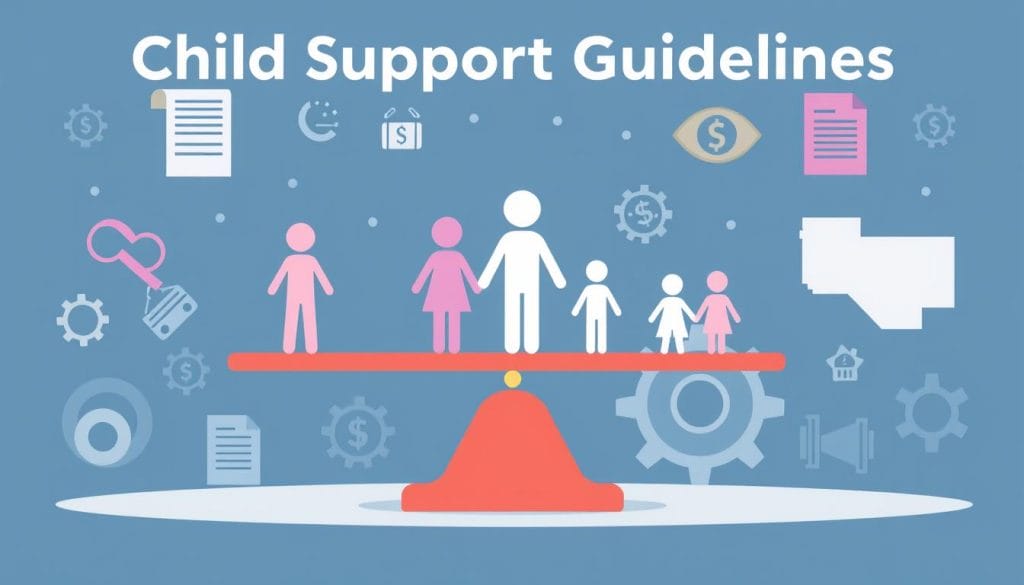Finding out how much child support for three kids costs is tricky. It depends on the state’s rules. Each state has its own way of figuring out child support payments. The amount usually depends on both parents’ income and the kids’ needs.
Studies show that child support for three kids might be about half of the non-custodial parent’s income. But, this can change based on many factors and the state’s rules.
This article will help clear up how child support for 3 kids is figured out in different states. It will look at the main rules and methods used. This way, parents can better understand and meet their children’s needs.
Knowing these details can help parents make better choices about child support. It’s all about making sure the kids are taken care of.
Understanding Child Support Basics
Child support is a law that makes sure both parents help with their kids’ needs after they split up. It covers things like food, a place to live, health care, and school. It’s very important because it helps keep the kids’ life stable and happy.
What is Child Support?
Child support is a deal between parents to help pay for their kids’ needs. It makes sure kids do well, even if their parents are not together. The amount is usually based on how much each parent makes and how much time the kids spend with them.
Importance of Child Support
Child support helps kids have a stable life. It makes sure they can go to school and have what they need. It’s very important for kids to grow up healthy and happy.
Key Factors Influencing Amount
Several things affect how much child support is paid. These include:
- Parental Income: How much each parent makes is very important. If one makes more, they might pay more.
- Time Spent with Children: Who spends more time with the kids can also change how much is paid.
- Additional Expenses: Things like daycare, health care, and special needs also play a part.
- State Guidelines: Each state has its own rules for how to figure out child support. For example, California has a special formula.
Knowing these things helps understand how child support is figured out. It shows why it’s so important for parents to talk openly. Keeping track of income and other important details is key for a fair amount.
| Factor | Description |
|---|---|
| Income Disparity | The difference in earnings between parents can directly influence child support amounts. |
| Parenting Time | The amount of time each parent spends with the child affects the calculation; more time spent may mean higher support owed. |
| Additional Expenses | Extra costs like childcare, medical expenses, and travel for visitation may increase required support. |
| State Regulations | Child support calculations vary by state, making it essential to consult local guidelines. |
State Guidelines for Child Support Calculations
Child support calculations are complex and vary by state in the U.S. Each state has its own rules for how much income goes to child support. These rules can change based on custody arrangements and how many children there are.
Variations Across States
Different states use different ways to figure out child support. For example:
- In seven states, the non-custodial parent’s income is multiplied by 20% for one child, 27% for two children, and 33% for three children. An extra 3% is added for each child after that.
- Three states—Delaware, Hawaii, and Montana—use the Melson Formula. This formula looks at both parents’ money and living costs.
- The District of Columbia uses a mix of methods. First, it bases child support on a percentage of income. Then, it adjusts based on the custodial parent’s income.
- Forty states use the income shares model. This model adds both parents’ incomes together to figure out support.
Common Calculation Methods
There are several ways to figure out child support:
| Calculation Method | Description | States Using This Method |
|---|---|---|
| Percentage of Income Model | Calculates child support as a fixed percentage of the non-custodial parent’s income. | 7 states |
| Melson Formula | Evaluates both parents’ financial needs and obligations before determining support. | Delaware, Hawaii, Montana |
| Income Shares Model | Calculates support based on combined parental income, reflecting the child’s standard of living. | 40 states |
Child support percentages vary a lot, from 7.3% to 25.1% of net income. Knowing these differences helps parents understand their child support rights and duties.

Determining Income for Child Support
Knowing how income is figured is key for child support. Courts look at the net income of both parents. This shows what each can pay for their kids. It’s important to know the difference between gross and net income.
Gross vs. Net Income
Gross income is what you earn before taxes and deductions. Net income is what you have left after these are taken out. In Illinois, child support is based on net income. This makes sure each parent pays based on what they can really afford.
Some things that can lower your net income include:
- Federal and state income taxes
- Social Security contributions
- Mandatory retirement contributions
- Health insurance premiums
- Prior child support or spousal maintenance payments
Additional Income Sources
Other than regular jobs, there are other ways income can come in. These include:
- Bonuses from work
- Overtime pay
- Money from investments
- Spousal maintenance payments
A child support calculator can give a good idea of what each parent might pay. It’s important to put in all the right financial information. Knowing about gross and net income, and other income sources, helps make sure the support is fair.
| Income Type | Gross Income | Net Income |
|---|---|---|
| Parent 1 | $75,000 | $55,000 |
| Parent 2 | $60,000 | $45,000 |
| Spousal Maintenance Received | $5,000 | $4,000 |
| Investment Income | $10,000 | $8,000 |
How Many Children Impact Child Support
The number of children greatly affects child support amounts. States often use per-child support adjustments. This means more children mean more money for support. A standard rule is about 20-25% of the non-custodial parent’s income for one child. More children add fixed amounts to this base.
Per-Child Support Adjustments
Per-child support adjustments are key in figuring out child support. They help show how more children mean more money for support. For example, three children might need 29% to 35% of the non-custodial parent’s income. This shows how different states have different rules.
Sliding Scale Models
Sliding scale models are another way to figure out child support. They adjust the amount of income expected for support as more children are added. This is important for families with many children. The amount starts at a certain percentage for one child, then goes down a bit for each additional child.

Understanding child support can be tricky. But knowing about per-child support adjustments and sliding scale models helps. For more details, check local guidelines or talk to a lawyer. Knowing these models helps ensure children get the support they need. For more info, see this link.
| Number of Children | Percentage of Income | Typical Average Payment |
|---|---|---|
| 1 | 20-25% | $441 |
| 2 | 25% | $550 |
| 3 | 29% | $617 |
| 4 | 31% | $650 |
| 5 or more | 35% | $700+ |
Other Factors Affecting Child Support Amounts
Figuring out child support is not just about how much money each parent makes. Parenting time and custody plans, and special needs, also play big roles. These factors can change how much support is needed.
Parenting Time and Custody Arrangements
How much time a parent spends with their kids affects child support. Parents with more time with their kids might pay less. This is because they share the costs of raising the children.
Courts look at how much time kids spend with each parent. They want arrangements that show both parents are involved.
- Less parenting time often results in higher child support obligations for the non-custodial parent.
- Agreements on child support may deviate from standard calculations but generally require court approval.
- Time spent with the child influences the overall support needed to meet their needs.
Special Needs Considerations
Children with special needs can change how much child support is needed. Parents of these kids often spend a lot on medical care and education. Courts may raise support to cover these costs.
Keeping detailed records of these expenses is key. It helps parents make a strong case to the court.
| Child Support Factors | Impact on Child Support |
|---|---|
| Parenting Time | Less parenting time typically leads to higher payments. |
| Custody Arrangements | Shared custody can lower financial obligations. |
| Special Needs Expenses | Increased support may be granted for medical and educational needs. |
Modification of Child Support Payments
Changing child support orders is key when life changes happen. Reasons for a change include income shifts, custody changes, or new expenses like medical bills. Each state has rules for this, and knowing the steps to request modification is vital for parents.
When Can Child Support Be Modified?
In Washington, you can ask to change child support at any time. This is especially true after big life changes. Changes can happen for many reasons:
- A job loss or a big change in salary.
- Changes in custody that affect costs.
- Big increases in expenses, like medical bills.
If a child support order is over a year old, you can ask for a change without showing a big change. This is if the order is hard on you or the child. Also, if the order is two years old, you can ask for a change if your income has changed or if child support rules have updated.
Steps to Request Modification
To change child support, you need to document everything and follow court rules. Here are the main steps to request modification:
- Gather Necessary Documentation: Get all financial documents, like income statements and new expense proof.
- Complete Required Forms: Fill out forms for changing child support, like the Petition to Modify Child Support. These forms are under FL Modify and FL All Family.
- File the Petition: Send the filled forms to court and keep a copy for yourself.
- Serve the Other Parent: Give the other parent a copy of the petition and summons. You can do this with Proof of Service.
- Attend the Hearing: Go to the court hearing. Here, you and the other parent can present your cases and discuss the changes.
Getting legal help for child support changes is a good idea. CLEAR can help at 888-201-1014. They can guide you through each step to make sure everything is done right.
Enforcement of Child Support Payments
Child support enforcement is key to making sure kids get money from both parents. Not paying child support has big consequences for the parent who doesn’t pay. Knowing the consequences of non-payment helps parents pay on time.
Consequences of Non-Payment
Those who don’t pay child support face penalties. These penalties aim to get them to pay. Here are some common ones:
- Wage garnishment, where some of the employee’s salary is taken for child support.
- Intercepting tax refunds for overdue support.
- Suspension of licenses, like driver’s and professional ones.
- Potential jail time for ignoring child support duties.
- Higher legal fees and court costs for enforcement actions.
Resources for Enforcement
There are many ways to help collect unpaid child support. State child support agencies are key in this effort. They have many tools, like:
- Asset freeze to stop access to assets until paid.
- Direct Deposit and Electronic Payment Card systems for secure payments.
- International Direct Deposit programs for parents abroad, ensuring payments.
Starting summer 2024, payments will go to parents who got cash help before. This change shows how important it is to get support to the right people. It highlights the need for strong child support enforcement.
| Enforcement Action | Description |
|---|---|
| Wage Garnishment | This action allows a percentage of an individual’s earnings to be directly deducted to cover child support obligations. |
| Tax Refund Interception | State agencies can intercept tax refunds to recover unpaid child support. |
| License Suspension | Non-custodial parents may face the suspension of various licenses if they do not comply with payments. |
| Jail Time | Those willfully failing to pay child support can serve time in jail for their disregard. |
| Asset Freeze | Assets can be frozen to compel the payment of overdue support amounts. |
Tips for Parents Navigating Child Support
Parents dealing with child support need smart strategies. Getting legal help from family law experts is key. They offer advice based on your situation, protecting your rights.
This step helps avoid misunderstandings of child support laws. It also keeps you safe from common problems in negotiations.
Seeking Legal Assistance
Legal advice is crucial, but using child support calculators is also helpful. These tools give a rough idea of what you might pay. They consider things like your income and who the kids live with.
But remember, calculators are just a starting point. They’re not the full answer. Using them first can help you talk better with a lawyer.
Utilizing Child Support Calculators
Also, don’t forget to contact local child support agencies. They have resources and info to help you. They might offer mediation or classes on child support laws.
These agencies are great for navigating the complex world of child support. They can be a big help.







